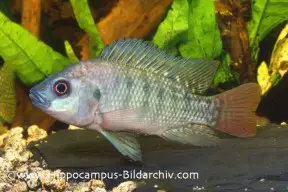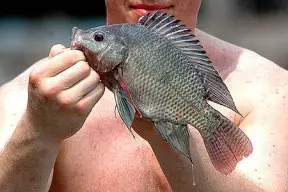Oreochromis niloticus niloticus
Nile Tilapia
Classification
Cichlidae
Distribution
O. n. niloticus has a very wide natural range and is native to (in alphabetical order) Burkina Faso, Cameroon, Chad, Egypt, Ethiopia, Gambia, Ghana, Guinea, Israel, Ivory Coast, Liberia, Mali, Niger, NIgeria, Senegal, Sierra Leone, Sudan, Togo and Uganda. It has also been introduced as a food fish in over 70 other countries and escaped or released populations now exist in many of these.
Habitat
An hardy and adaptable species that is found in a wide range of habitats, including rivers, streams, ponds, lakes and coastal plains. It occurs in both fresh and brackish waters and usually inhabits shallow areas.
Maximum Standard Length
24″ (60cm), but usually much smaller, around 14″ (35cm).
Aquarium SizeTop ↑
80″ x 24″ x 24″ (210cm x 60cm x 60cm) – 760 litres for adult fish. Juveniles can be grown on in smaller aquaria.
Maintenance
Not critical. A sandy substrate is best. Plants should not be used as they will be eaten and a large, efficient filtration system is essential as this species is very messy. Otherwise decor is down to personal preference.
Water Conditions
Temperature: 70-81°F (21-27°C), although it is found over greater extremes in nature.
pH: 6.2-8.5
Hardness: 10-30°H
Diet
Very unfussy and will eat most foods offered. Some vegetable matter should be included in the diet.
Behaviour and CompatibilityTop ↑
A very robust species that is territorial when spawning but is otherwise quite peaceful. Obviously an enormous tank is needed to keep it in a community situation. It can be combined successfully with large African and Central American cichlids, Loricariids, Synodontis sp. etc. Small fish will be eaten. If kept with others of it’s own species, they will squabble amongst themselves but rarely is any real damage done unless breeding occurs.
Sexual Dimorphism
Male fish develop pointed dorsal and anal fins while the female’s are rounded.
Reproduction
Easy. Maternal mouthbrooder. We recommend the purchase of 5 or 6 youngsters and allowing them to pair up naturally. Obviously, a massive tank is required but water parameters are less important. Aim for a temperature of 75°F and a pH of around 7.0 and you will be fine. Sand is the preferred substrate.
Spawning is initiated by the male who excavates a pit in the substrate to act as the spawning site. He will then guard this area fiercely and attempt to entice females to mate with him. A willing female lays her eggs directly onto the substrate of the spawning pit and allows the male to fertilise them before taking them into her mouth. The male now plays no further part in broodcare and the female does not remain in his territory.
The female will carry the brood for around 5-7 days before releasing the free swimming fry. Generally, she will not eat during this period and can easily be spotted by her distended buccal cavity. Following release of the fry, broodcare by the female lasts for another 2-3 weeks, with the fry seeking refuge in her mouth if threatened or distressed.
The fry grow very quickly indeed and are sexually mature at only 6 months of age. They can be fed on brine shrimp nauplii or powdered flake food from the day they become free swimming.
NotesTop ↑
One of the most invasive fish species in the world but also one of the most economically important, O. niloticus is bred in huge numbers in many countries as a food fish. It is often cross-bred with other Oreochromis species for colour in order to make the fish more appealing to consumers.
The destructive effect of O. niloticus on non-native ecosystems into which it escapes or is released is mainly due to it’s adaptibility. It has been recorded over a temperature range of 60-110°F and in water varying from pure freshwater to full marine conditions. It is often described as an “aquatic dustbin” as it eats virtually anything and it breeds under almost any conditions, even when food is scarce. The broods themselves number several hundred and a single female can produce 3 or 4 a year. They also become sexually mature at only a few months of age.
O. niloticus is not particularly common in the hobby and despite it’s hardiness, does not make a good aquarium subject. It has a large adult size, a messy nature and is not especially attractive, nor does it exhibit any particularly interesting behaviour. The ease with which the fish breeds, and resultant large broods of swiftly growing fry can also spell trouble as the young are not at all popular with dealers and other hobbyists.




May 12th, 2015 at 10:50 am
Im from Slovenia. We have them in one of our spa centers. They are thriveing in waste water release from spa center. Constant 25c water, even in winter when temps drop to -15c. Billions of them. Up to 35cm. I Use them in my aquaponics